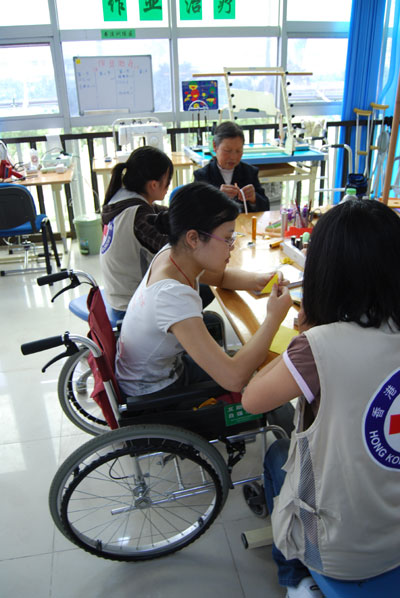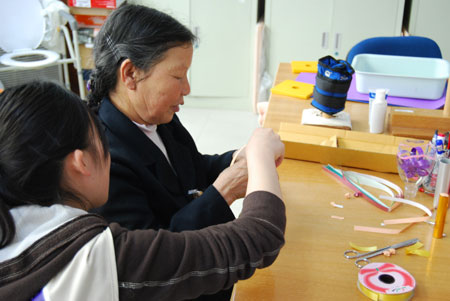By John Sexton
China.org.cn reporter from Sichuan
Liu Chunyan was at a safety meeting in the office of the coal mine where she worked when the May 12 earthquake struck. She and her colleagues ignored the initial tremor, as they were accustomed to frequent minor earthquakes. It was a tragic mistake, for a few seconds later the full force of the quake left them no chance to escape. Liu Chunyan lay trapped for 24 hours before she was rescued. Her left leg was shattered and had to be amputated above the knee. She was partially paralyzed from the waist down and lost movement in her right foot. Nineteen of the thirty people at the meeting died.
 Watch how Red Cross helps quake victims walk again >>>
Watch how Red Cross helps quake victims walk again >>>
Sitting on the edge of her bed, with her mother looking on Liu Chunyan said "I am still young. Of course I'm optimistic. I have to carry on, because I have a 12 year old child and I have to set an example."
 |
|
Patients take part in an occupational therapy session at a Rehabilitation, Prosthetics and Orthotics Center in Deyang City, Sichuan Province. The center was set up by the Hong Kong Red Cross in June, 2008. [Photo by John Sexton, China.org.cn] |
Liu Chunyan is a patient at the Rehabilitation, Prosthetics and Orthotics Center set up last year by the Hong Kong Red Cross in Deyang, a small city about an hour's drive from Chengdu. Specialists at the center have fitted her with an artificial limb and a special brace that gives her control of her right foot. With the two combined, Liu Chunyan can walk, "not a long way," she says, "but I have made far more progress here than in other places."
The Red Cross center was set up in June 2008 by the Hong Kong Red Cross in collaboration with the Deyang Disabled People's Federation. By September its city center premises had been had remodeled to include a clinic, workshops, training spaces and an accommodation wing. "The center is a one-stop shop that manufactures artificial limbs on the premises and provides all-round long term care including occupational therapy and psychotherapy," said Francis Markus, China spokesman for the International Federation of Red Cross Societies.
Technical chief Peter Tsang has been working in the field of prosthetics (artificial limbs) and orthotics (braces and other devices to help patients use damaged limbs) for 38 years. The retired Hong Kong district hospital chief had been a medical volunteer in Guangdong Province for 15 years, so after the Wenchuan earthquake struck last May he was a natural choice when the Hong Kong Red Cross looked for someone to move to Sichuan to establish the center.
Dr Tsang is passionate about his work and especially about the need to pay close attention to individual needs. "You can't just give a person an artificial limb and say go on your way," he said. The Deyang center offers a full package of care, including limb fitting, training in the use of prosthetics and, importantly, psychological care. Individual crafting and fitting is the key to successful treatment, he says, repeating several times his maxim that "the socket is the soul of the prosthesis".
|

|
|
Patients take part in an occupational therapy session at a Rehabilitation, Prosthetics and Orthotics Center in Deyang City, Sichuan Province. The center was set up by the Hong Kong Red Cross in June, 2008. [Photo by John Sexton, China.org.cn] |
In two large workshops artificial limbs are manufactured by a team of young men and women, some local and some from other parts of China. Each of them has at least three years training at an institute and several more years of on the job training. Using plaster casts taken from patients they painstakingly craft each prosthetic device to meet the precise needs of the individual.
Every fortnight a team of surgeons and other specialists fly in from Hong Kong to hold a weekend clinic attended by upwards of 80 patients. The official catchment area of the clinic is Deyang and its surrounding counties, but patients arrive here from all parts of Sichuan, often referred by NGOs. No-one is turned away, said Dr Tsang. So far they have fitted around 480 artificial limbs. In special exercise areas, or just walking in the corridors, patients of all ages are getting accustomed to their new limbs.
One of the main attractions of the center is that it provides treatment to earthquake victims entirely free of charge. This includes not only medical care and equipment but also, importantly for people who were often already poor before the earthquake took away their livelihood, free accommodation and food during their stay. The center even covers all patient travel costs including those of visiting relatives.
Ocean Hung, a young clinical psychologist from Hong Kong, told us between 30 and 40 percent of patients attending the center require psychological treatment to help them adjust to the loss of a limb or reduced mobility. Many patients are also grieving for lost loved ones or suffering from post-traumatic stress disorder. Arranged on a table in his small office is a group of cuddly toys, a poignant reminder that many of his patients are small children.
Dr Tsang told us the Hong Kong Red Cross has set aside 50 million yuan (US$7.3 million) to fund the project for five years, a period long enough, he said, to ensure that earthquake survivors like Liu Chunyan receive the aftercare they need, and for mainland China staff to be trained to take over the running of the center.
(China.org.cn May 10, ?2009)